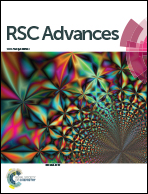The effects of divalent copper on performance, extracellular polymeric substances and microbial community of an anoxic–aerobic sequencing batch reactor
Abstract
The effects of divalent copper (Cu(II)) on the performance, extracellular polymeric substances (EPS) and microbial community of activated sludge were investigated in an anoxic–aerobic sequencing batch reactor (SBR). The removal efficiencies of chemical oxygen demand (COD) and ammonia nitrogen (NH4+-N) decreased with the increase of influent Cu(II) concentration from 0 to 50 mg L−1. The specific oxygen utilization rate (SOUR), specific ammonium oxidation rate (SAOR), specific nitrite oxidation rate (SNOR), and specific nitrate reduction rate (SNRR) decreased with the increase of influent Cu(II) concentration. The protein (PN) contents in the loosely bound EPS (LB-EPS) and tightly bound EPS (TB-EPS) increased from 3.67 and 4.73 mg g−1 VSS to 32.83 and 50.45 mg g−1 VSS with the increase of influent Cu(II) concentration from 0 to 50 mg L−1, respectively. The polysaccharide (PS) contents in the LB-EPS and TB-EPS increased from 1.44 and 2.68 mg g−1 VSS to 8.51 and 19.84 mg g−1 VSS with the increase of influent Cu(II) from 0 to 50 mg L−1, respectively. The three-dimensional excitation–emission matrix (3D-EEM) fluorescence spectra and Fourier transform infrared (FTIR) spectra illustrated that the addition of Cu(II) to the influent had distinct effects on the functional groups of PN and PS in the LB-EPS and TB-EPS. The sludge volume index (SVI) showed a negative correlation with LB-EPS (or TB-EPS) content at different Cu(II) concentrations. Some microorganisms adapting to high Cu(II) concentration became predominant bacteria, while others without Cu(II)-tolerance capacity gradually depleted or weakened with the increase in Cu(II) concentration.


 Please wait while we load your content...
Please wait while we load your content...